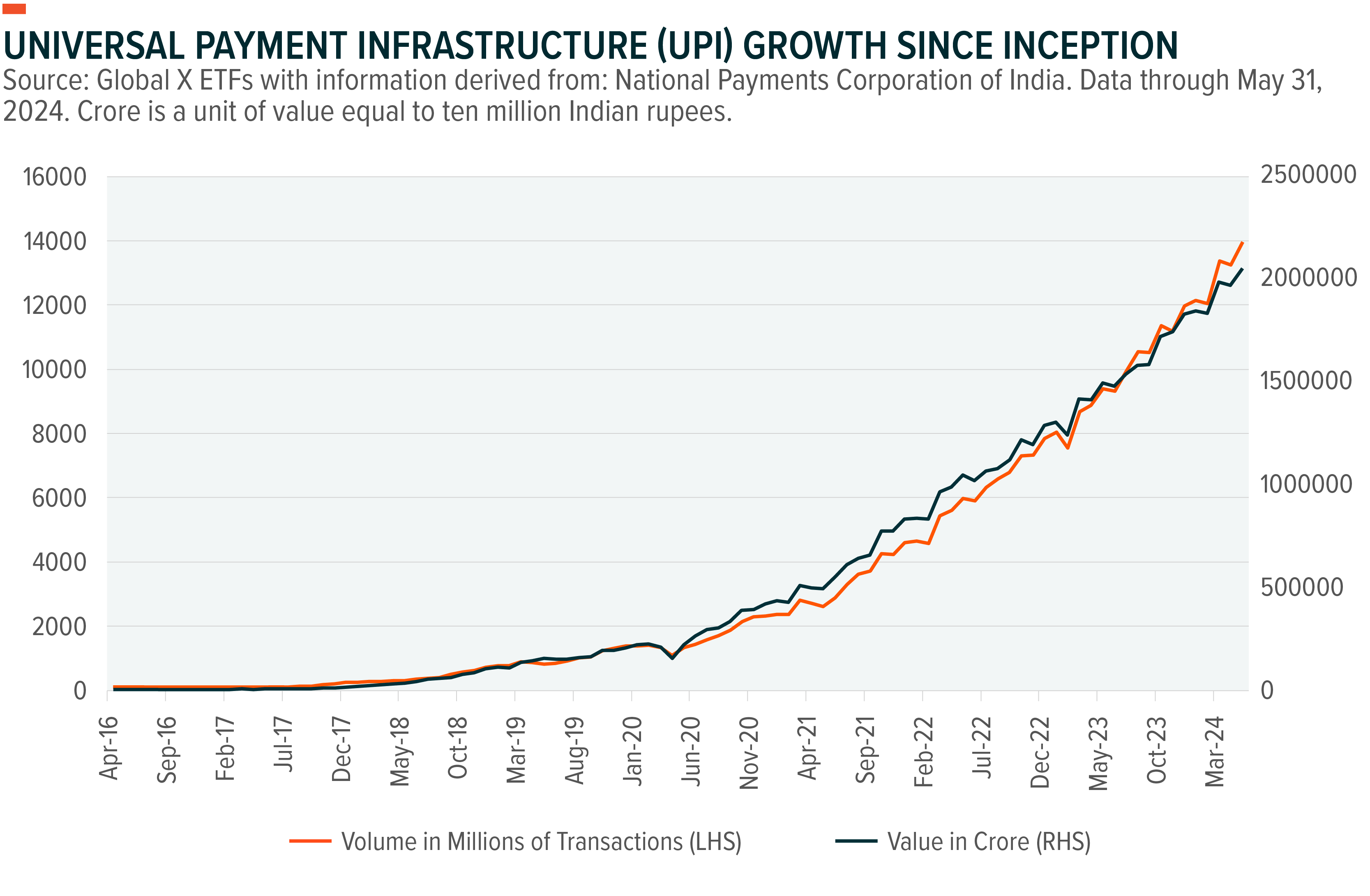Opportunities within the Nifty 50
India’s digital journey is one of inertia. India launched its “Digital India Program” in 2015, which has driven “new economy” sectors from ~5% to ~15% of gross domestic product (GDP), as structural reforms have opened the door to everyone from start-ups to multinationals to finally take advantage of India’s leading tech-stack.(1) Furthermore, government incentives are now helping drive additional long-term growth opportunities. In turn, we see an abundance of investment opportunities for investors looking at India.
Key takeaways
- The Indian digital journey started nearly a decade ago with the Digital India Program, and the economy is now reaping its harvest.
- Reforms and incentives are supporting a shift in foreign direct investment (FDI) intentions, which will likely support long-term growth in India, especially within the “new” digital economy.
- We believe these rapid changes are creating a tailwind for the Nifty 50 which provides access to multiple tech giants leading the digitisation effort.
The launch of digital India
The 2015 Digital India Program was based on three key pillars to help connect citizens and the government via e-services.
- Robust Digital Infrastructure (Identity): The first pillar to support the digital revolution was based on initiatives like Aadhaar, a unique digital identity program that helps millions of Indians access essential services and financial inclusion. Before the launch of Aadhaar, only one in 25 people had formal identification and only one in four had a bank account.(2) The online bio-metric digital identity system now covers over 1.35bn people and has helped improve the know your customer (KYC) process, reducing the cost of e-KYC from US$12 to just US$0.06 (cents).(3)
- Accessible Government Services (Payments): The second pillar was based on UPI – Universal Payment Infrastructure. UPI is helping formalise the digital economy by deepening financial inclusion as it helps small and unbanked businesses/individuals create financial records and credit histories, which then allow for the development of e-commerce. UPI transaction value grew from US$12bn in FY17-18 to US$1.66tn in FY22-23, with 118bn transactions in 2023.(4)

- Empowered Citizens (Data): The third pillar is focused on building an account aggregator framework that could transform the credit industry in India. In short, account aggregators act as consent managers that manage data-sharing across different institutions using the DEPA (Data Empowerment and Protection Architecture) infrastructure, which was launched in 2021.(5) In turn, this helps solve the common issues of a lack of collateral and/or non-standard loan requirements. It also reduces the often-high cost of acquiring and verifying financial documents.
Roadmap for Development
Indian companies benefit from a unique infrastructure to drive innovation. The fact that the “India Stack” offers a set of open application programming interfaces (API) means entrepreneurs can leverage national infrastructure to develop services targeting all Indians.
India has expanded high speed internet networks across the country to help citizens take up the use of digital services. Smartphone penetration has grown from around 250mn in 2015 to over 1bn in 2023 with close to a 71% penetration rate.(6) Within these 1bn smartphones, over 350mn cost only ~USD18, but are still interoperable with UPI.(7)
This has fostered the growth of the digital economy, underpinned by innovation and entrepreneurship. We believe domestic innovation is the next logical step, as India has already been a services powerhouse for global tech companies for years. In fact, the Google for India Digitisation Fund will invest USD10bn by 2025 to help MSMEs (micro, small, and medium enterprises) digitise their business operations; Microsoft plans to train 100k developers in India in the latest AI tech and tools under its AI Odyssey initiatives.(8,9)
The National Payments Corporation of India (NPCI) launched UPI in 2016. UPI was created by a consortium of the Reserve Bank of India (RBI), public and private banks, and the government. UPI provides a 24/7, immediate, mobile-first payment system that provides an open API, unlike the closed payment system in neighbouring China.(10) This open architecture within the “India Stack” has driven private players to incorporate various applications, leading to a massive increase in UPI transactions. The result is increased efficiency in transactions, improved financial inclusion, and lower informality in the economy. This has set a stage for companies to grow with digital payment and lending capabilities that could increase cross-selling opportunities, cut costs, and boost profitability.
Digitisation Giants in the Nifty 50
The Nifty 50 is India’s premier index tracking 50 of the country’s most established and industry leading firms. Below we highlight three tech giants within the index which we believe offer significant exposure to the megatrend of India’s digitisation.
Tata Consultancy Services:
TCS is a global leader in IT services, consulting, and business solutions, playing a pivotal role in India’s digitisation. It provides software development, system integration, and consulting services to a wide range of industries. TCS has contributed significantly to India’s digital infrastructure, including government projects like the Passport Seva project and several digital banking solutions. India’s Passport Seva Project was launched in 2010 to digitise and streamline the passport application and issuance process in India.(11) This public-private partnership transformed passport services by introducing online applications, digital records, and efficient service delivery, significantly reducing processing times. The project also included the establishment of a toll-free call centre offering support in 17 languages. The success of this initiative led to the implementation of the second phase, focusing on the issuance of e-passports and further technological enhancements like biometrics and AI integration.(12)
HCL Technologies Ltd:
HCL Technologies offers IT and business consulting services, with a strong emphasis on digital transformation. The company provides solutions in areas such as cybersecurity, cloud computing, and digital analytics. HCL Technologies has partnered with various Indian enterprises and government bodies, in particular, HCL Technologies was responsible for modernising the IT infrastructure of State Bank of India, integrating digital banking services and improving customer access and service delivery. This April, HCLSoftware, the software business unit of HCL Technologies was once again announced as the State Bank of India’s solutions partner for the bank’s new digital transformation program. (13) As part of the contract, the company will provide AI capabilities and comprehensive campaign management tools to the bank, improving their ability to engage with its customers. (14)
Bharti Airtel Ltd:
Bharti Airtel is a major telecommunications provider in India, offering mobile, broadband, and digital TV services. It has played a crucial role in expanding internet connectivity and digital access across the country. Airtel’s initiatives, such as the rollout of 4G and the launch of digital platforms like Airtel Thanks and Wynk Music, have significantly contributed to the digital empowerment of millions of Indians. One of the firm’s biggest achievements is the rollout of Airtel Payments Bank in 2017. (15) Airtel Payments Bank is a fully digital banking service, providing accessible banking solutions to millions of unbanked and underbanked individuals in India. The firm has benefited immensely from the proliferation of UPIs with the Airtel Payments Bank responsible for up to 80.4 million users and over US$11 billion in gross transaction value in FY2023-24. (16)
A Digital India
Digital India is inclusive and prosperous. Before the Covid-19 pandemic, 92% of MSMEs in India still lacked access to formal credit.(17) Digital India is changing that. It is increasing efficiencies, improving competitiveness, helping bridge the rural economic divide, and is likely setting up the country for another decade of growth. MSMEs represent roughly 30% of GDP and nearly 50% of exports, so their digital development and transformation could create step-change economic growth.(18) Today, the “India Stack” remains the global benchmark for digital programs, and we are encouraged to see how the wide scale adoption of UPI and digital payments is helping formalise and grow the economy. As the Indian economy goes through powerful and structural transitions, the Nifty 50 index is an attractive option for investors looking to take part in the opportunity.
The Global X India Nifty 50 ETF (ASX: NDIA) invests in 50 of the largest companies listed in India.

1 topic
1 stock mentioned
1 fund mentioned

